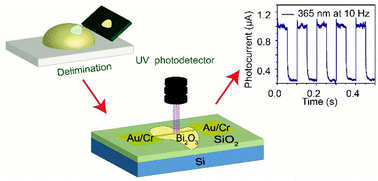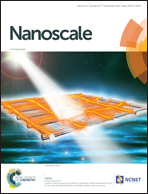Bi2O3 monolayers from elemental liquid bismuth†
Abstract
Atomically thin, semiconducting transition and post transition metal oxides are emerging as a promising category of materials for high-performance oxide optoelectronic applications. However, the wafer-scale synthesis of crystalline atomically thin samples has been a challenge, particularly for oxides that do not present layered crystal structures. Herein we use a facile, scalable method to synthesise ultrathin bismuth oxide nanosheets using a liquid metal facilitated synthesis approach. Monolayers of α-Bi2O3 featuring sub-nanometre thickness, high crystallinity and large lateral dimensions could be isolated from the liquid bismuth surface. The nanosheets were found to be n-type semiconductors with a direct band gap of ∼3.5 eV and were suited for developing ultra violet (UV) photodetectors. The developed devices featured a high responsivity of ∼400 AW−1 when illuminated with 365 nm UV light and fast response times of ∼70 μs. The developed methods and obtained nanosheets can likely be developed further towards the synthesis of other bismuth based atomically thin chalcogenides that hold promise for electronic, optical and catalytic applications.



 Please wait while we load your content...
Please wait while we load your content...